Snacks Statistics 2024 By Health, Types, Options
At Market.us Media, we strive to bring you the most accurate and up-to-date information by utilizing a variety of resources, including paid and free sources, primary research, and phone interviews. Our data is available to the public free of charge, and we encourage you to use it to inform your personal or business decisions. If you choose to republish our data on your own website, we simply ask that you provide a proper citation or link back to the respective page on Market.us Media. We appreciate your support and look forward to continuing to provide valuable insights for our audience.
Table of Contents
Introduction
Snacks Statistics: The snacks industry worldwide is thriving and continuously expanding, offering a diverse selection of convenient and enjoyable food choices.
Its growth is driven by changing lifestyles and evolving consumer preferences, with snack options like chips, pretzels, popcorn, and nuts becoming increasingly favored.
These snack products are available to consumers through various channels, including conventional retail outlets and online platforms.
Consumer decisions regarding snacks are increasingly influenced by health considerations and a growing emphasis on sustainability.
Within this sector, challenges and possibilities exist simultaneously, and competition spurs innovation and adaptation to meet evolving consumer needs.

Editor’s Choice
- In 2023, the global snacks market revenue stood at USD 1,220.9 billion.
- Projections for 2032 anticipate the total snacks market revenue to reach USD 1,720.7 billion. With frozen & refrigerated snacks at USD 481.8 billion. Savory snacks at USD 378.6 billion, confectionery snacks at USD 258.1 billion, fruit snacks at USD 189.3 billion, bakery snacks at USD 137.7 billion, and other products at USD 275.3 billion.
- Supermarkets & hypermarkets hold the largest market share, commanding a substantial 43% of the distribution channel. Emphasizing their significant role in making snacks accessible to consumers worldwide.
- Notably, by 2022, the average revenue per capita had risen to $34.93 for cookies and crackers, $11.42 for potato chips, and $20.32 for tortilla chips, flips, and pretzels.
- The United States is the top revenue generator, with an impressive revenue of $114 billion.
- On average, women tend to consume approximately 3.1 snack items daily, whereas men typically consume around 2.7.
- Globally, consumers prioritize snacks that contain no additives or preservatives (40%) and lack artificial ingredients (34%). More feature natural ingredients with a clean label (33%) as their top choices for healthier snacks.
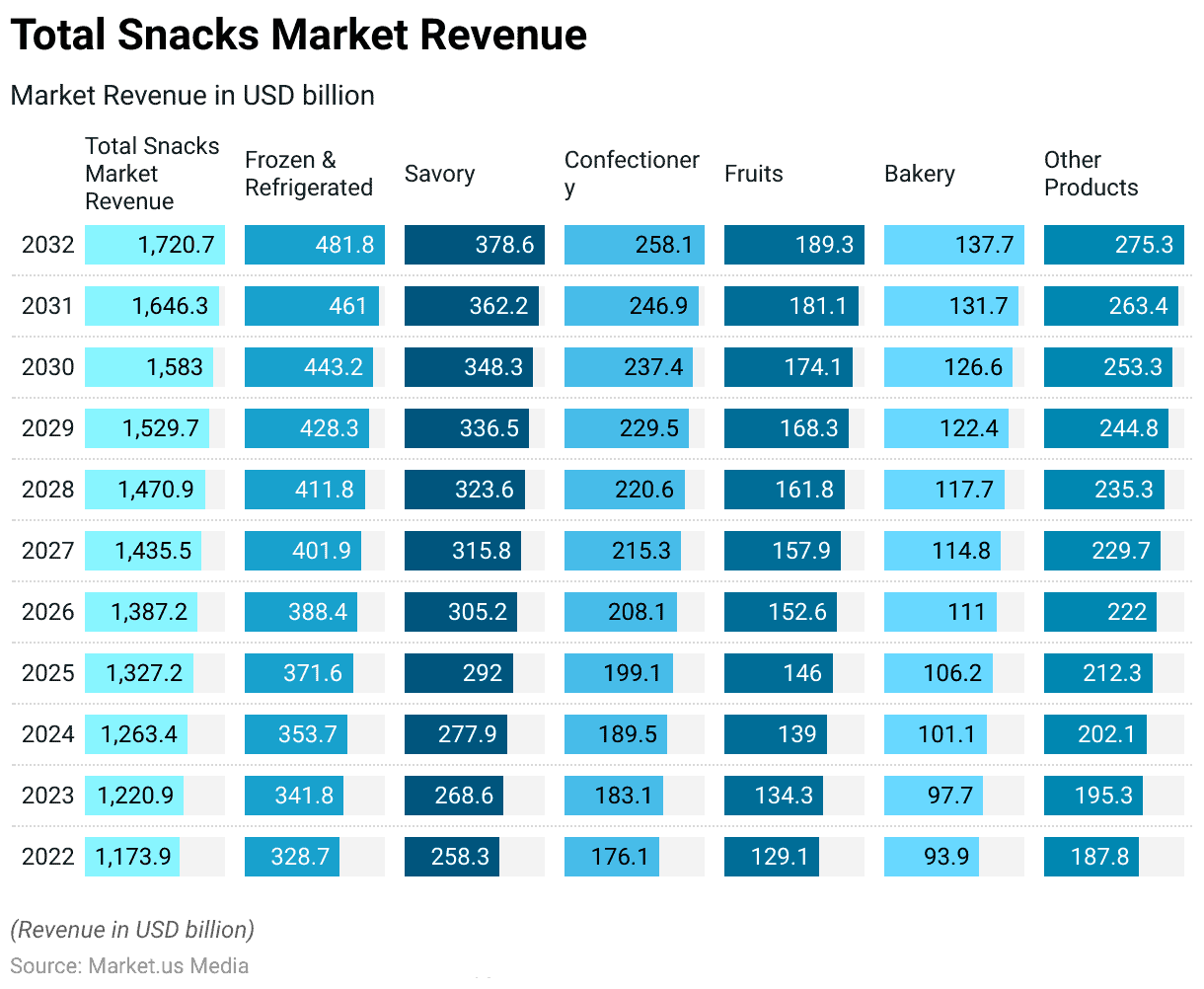
Global Snacks Market Overview
Global Snacks Market Size Statistics
- The global snacks market has displayed a consistent upward trajectory in revenue over the past decade at a CAGR of 4.0%.
- In 2022, the market’s revenue stood at USD 1,173.9 billion, marking the starting point of this growth trend.
- Subsequently, in 2023, it experienced a notable increase to reach USD 1,220.9 billion.
- Projections indicate that this positive momentum is set to continue. With anticipated revenues of USD 1,263.4 billion in 2024 and USD 1,327.2 billion in 2025.
- Looking ahead, the market is expected to surpass significant milestones. With revenues of USD 1,387.2 billion in 2026, USD 1,435.5 billion in 2027, and USD 1,470.9 billion in 2028.
- The growth is predicted to remain robust, reaching USD 1,529.7 billion in 2029 and USD 1,583.0 billion in 2030.
- As we progress into the early 2030s, the global snacks market is forecasted to continue its expansion, with projected revenues of USD 1,646.3 billion in 2031 and USD 1,720.7 billion in 2032.
- This consistent growth trajectory underscores the enduring popularity and market demand for snacks on a global scale.
(Source: Market.us)
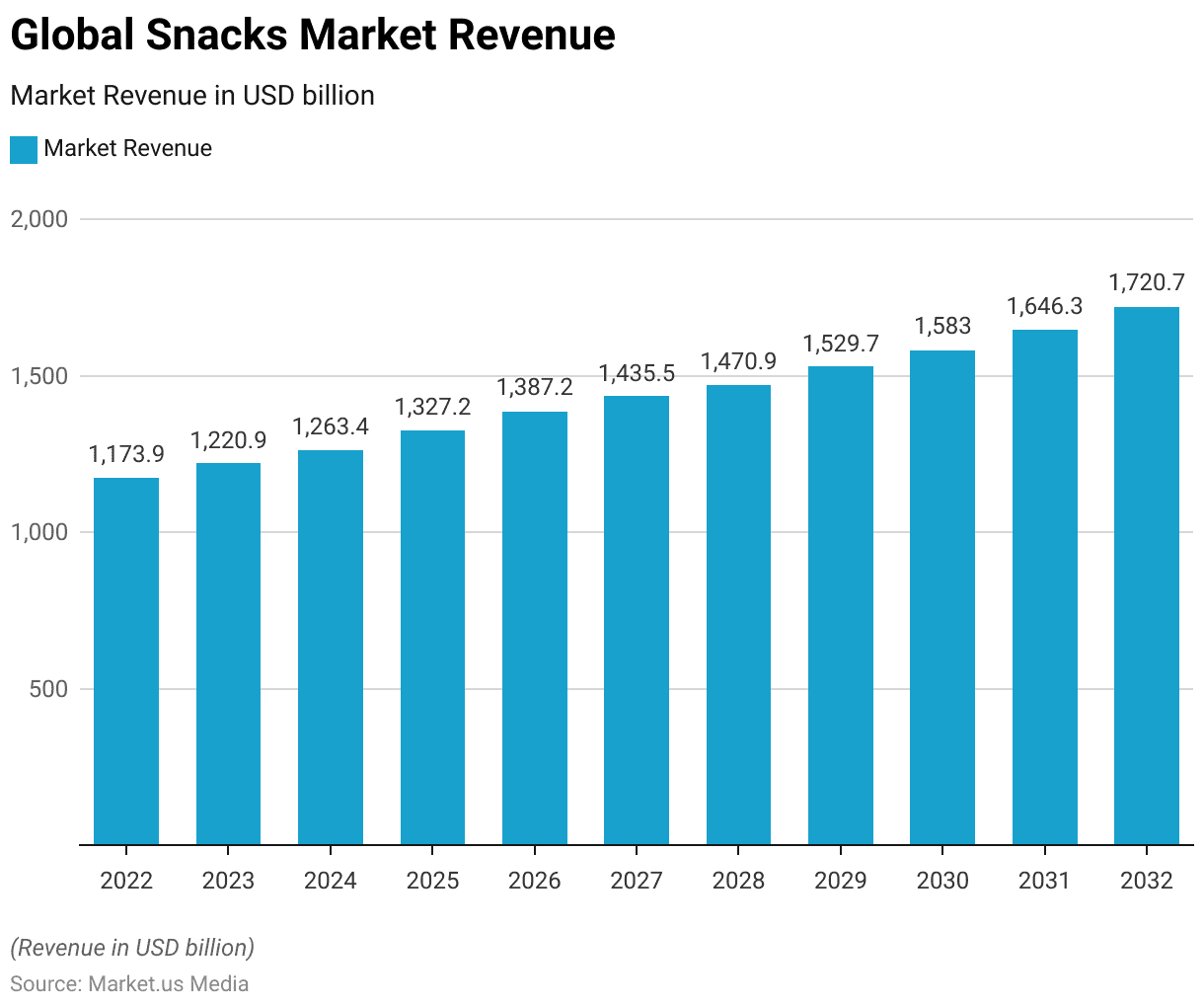
Global Snacks Market Size – By Product Statistics
- The global snacks market exhibits a diverse range of product categories, each contributing to its overall revenue growth.
- In 2022, the total snacks market revenue amounted to USD 1,173.9 billion. With distinct segments including frozen & refrigerated snacks generating USD 328.7 billion. Savory snacks at USD 258.3 billion, confectionery snacks totaling USD 176.1 billion. Fruit snacks with USD 129.1 billion, bakery snacks accounted for USD 93.9 billion, and other products contributed USD 187.8 billion.
- As we move forward into the future, these segments are expected to continue their upward trajectory.
- Projections for 2032 anticipate the total snacks market revenue to reach USD 1,720.7 billion. With frozen & refrigerated snacks at USD 481.8 billion, and savory snacks at USD 378.6 billion. Confectionery snacks at USD 258.1 billion, and fruit snacks at USD 189.3 billion. Bakery snacks at USD 137.7 billion, and other products at USD 275.3 billion.
- This data underscores the dynamism and growth potential within the global snacks market. Reflecting consumer preferences for a wide variety of snack options across different product categories.
(Source: Market.us)
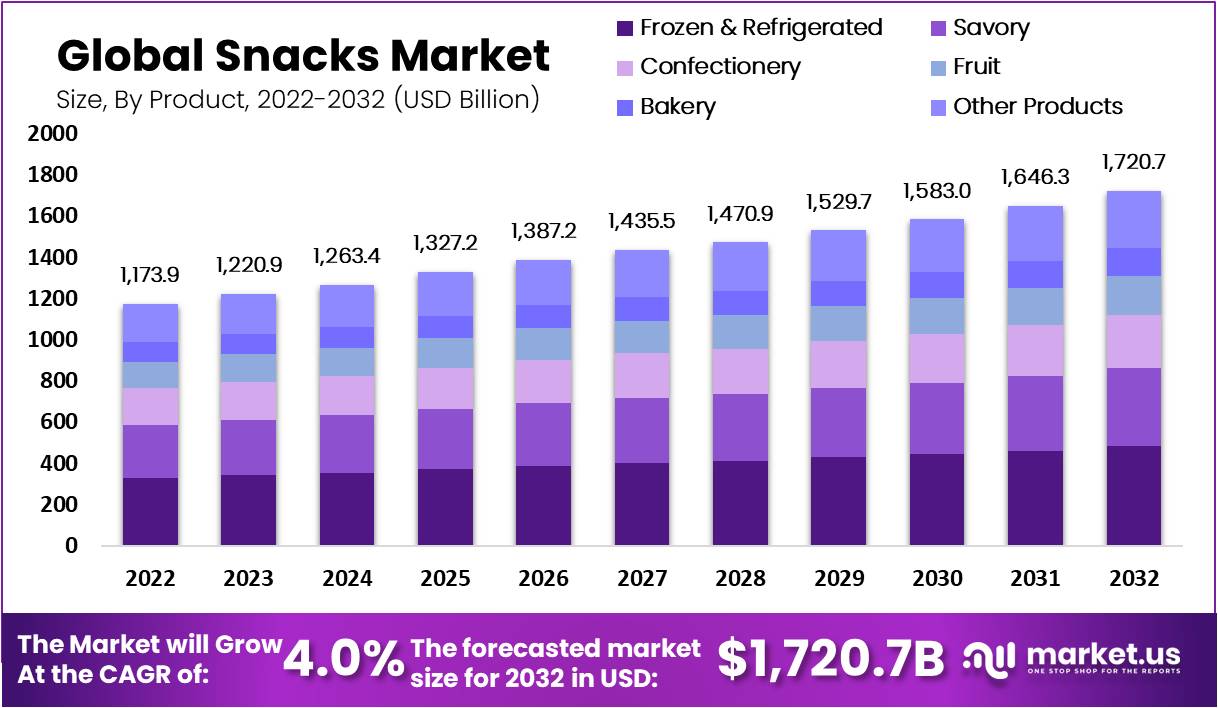
Global Snacks Market Share – By Distribution Channel Statistics
- The distribution landscape within the global snacks market is characterized by a diverse array of channels.
- Supermarkets & hypermarkets hold the largest market share, commanding a substantial 43% of the distribution channel. Emphasizing their significant role in making snacks accessible to consumers worldwide.
- Convenience stores follow closely, accounting for 23% of the market share. Reflecting the convenience-seeking behavior of consumers who prefer quick and easy access to snacks.
- The online channel, representing 21% of the market share, has seen notable growth. Driven by the increasing trend of e-commerce and the convenience it offers in snack purchases.
- Other distribution channels, comprising 13% of the market share, encompass a variety of retail outlets, emphasizing the presence of niche and specialized avenues for snack distribution.
- This distribution landscape underscores the importance of multiple channels in catering to diverse consumer preferences and ensuring the global accessibility of snacks.
(Source: Market.us)

Global Snacks Market Average Revenue Per Capita Statistics
- The global snacks market has exhibited consistent growth in average revenue per capita over the past decade.
- In 2018, the average revenue per capita for cookies and crackers stood at $28.83, while potato chips, tortilla chips, flips, and pretzels recorded figures of $9.76 and $17.75, respectively.
- This upward trend continued through 2019, 2020, and 2021, with steady increases in all three categories.
- Notably, by 2022, the average revenue per capita had risen to $34.93 for cookies and crackers, $11.42 for potato chips, and $20.32 for tortilla chips, flip, and pretzels.
- Projections indicate that this growth trajectory will persist, reaching $39.69, $12.66, and $22.25 for the respective categories by 2024.
- Looking further ahead, by 2028, these figures are expected to reach $49.74, $15.20, and $26.60, reflecting the enduring appeal and market expansion of these snack segments.
- This data underscores the sustained demand and profitability of the global snacks industry.
(Source: Statista)
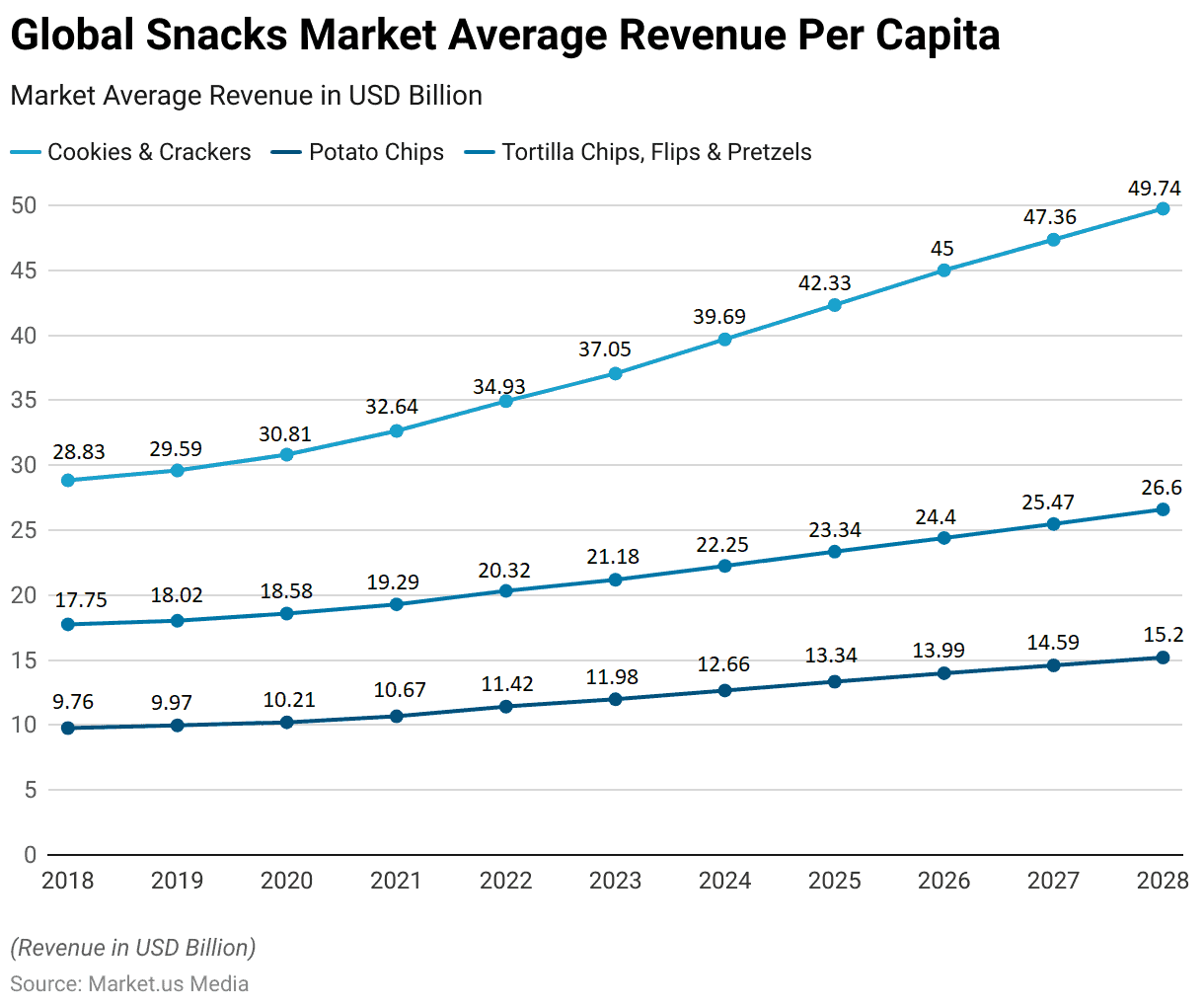
Snacks Industry Regional Statistics
Snacks Industry Revenue – By Country
- The global snacks industry has seen substantial revenue contributions from various countries, reflecting the widespread popularity of snack products.
- Leading the pack, the United States stands as the top revenue generator, with an impressive revenue of $114 billion.
- Following closely behind, Japan contributes significantly with $82 billion in snack industry revenue.
- India and China, two emerging markets, also make noteworthy contributions, with $75 billion and $64 billion, respectively.
- Mexico, Russia, and Canada, while relatively smaller in scale, each play their part, contributing $14 billion, $13 billion, and $12 billion to the industry’s overall revenue.
- These figures highlight the diverse landscape of the snacks industry, with both established and emerging markets driving substantial revenues and reflecting the global appeal of snack products.
(Source: Statista)
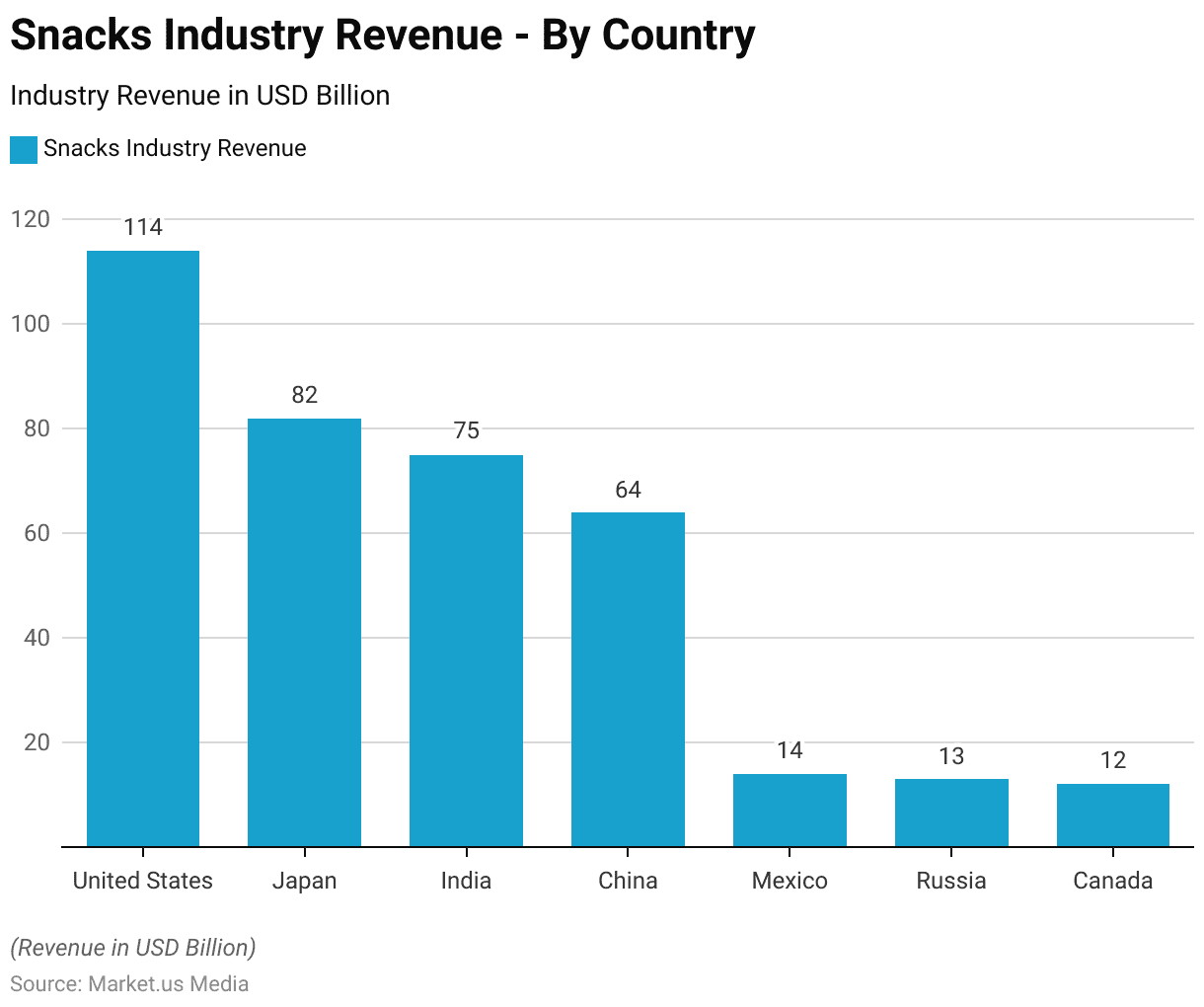
Commonly Consumed Snacks- By Region
United States
- In the United States, a significant portion of snack enthusiasts indulge in various snack categories at least once a week, revealing distinct preferences among consumers.
- Notably, chips or crisps lead the pack, with 53% of snackers enjoying them every week.
- Nuts, seeds, or dried fruits closely follow, with 51% of consumers incorporating these healthy options into their weekly snacking routines.
- Similarly, candy and chocolate bars share the same percentage of 51% in weekly consumption, indicating a sweet tooth among a substantial portion of the population.
- Cookies also hold a notable presence, with 43% of snackers savoring them regularly.
- Meanwhile, ice cream, though slightly less frequent, still captures a significant audience, with 34% of individuals enjoying this frozen treat weekly.
- These statistics provide insights into the snack preferences of the American market, reflecting a diverse range of choices that cater to various taste preferences and snacking occasions.
(Source: YouGov)

Great Britain
- In Great Britain, the weekly snacking habits of consumers reveal distinct preferences for various snack categories.
- Chips or crisps are particularly popular, with a significant 73% of snackers enjoying them at least once a week.
- Nuts, seeds, or dried fruits also have a strong presence, with 65% of individuals incorporating these wholesome options into their weekly snacking routines.
- Candy and chocolate bars, known for their sweet indulgence, maintain a notable following, with 62% of consumers savoring them regularly.
- Cookies, while slightly less frequent, still find favor with 41% of snackers, showcasing their enduring appeal.
- Additionally, ice cream, a classic treat, remains a favorite among 39% of the population, further emphasizing the diverse range of snack preferences in the Great British market.
- These statistics underscore the rich variety of snacking choices available and the distinct tastes of British consumers.
(Source: YouGov)
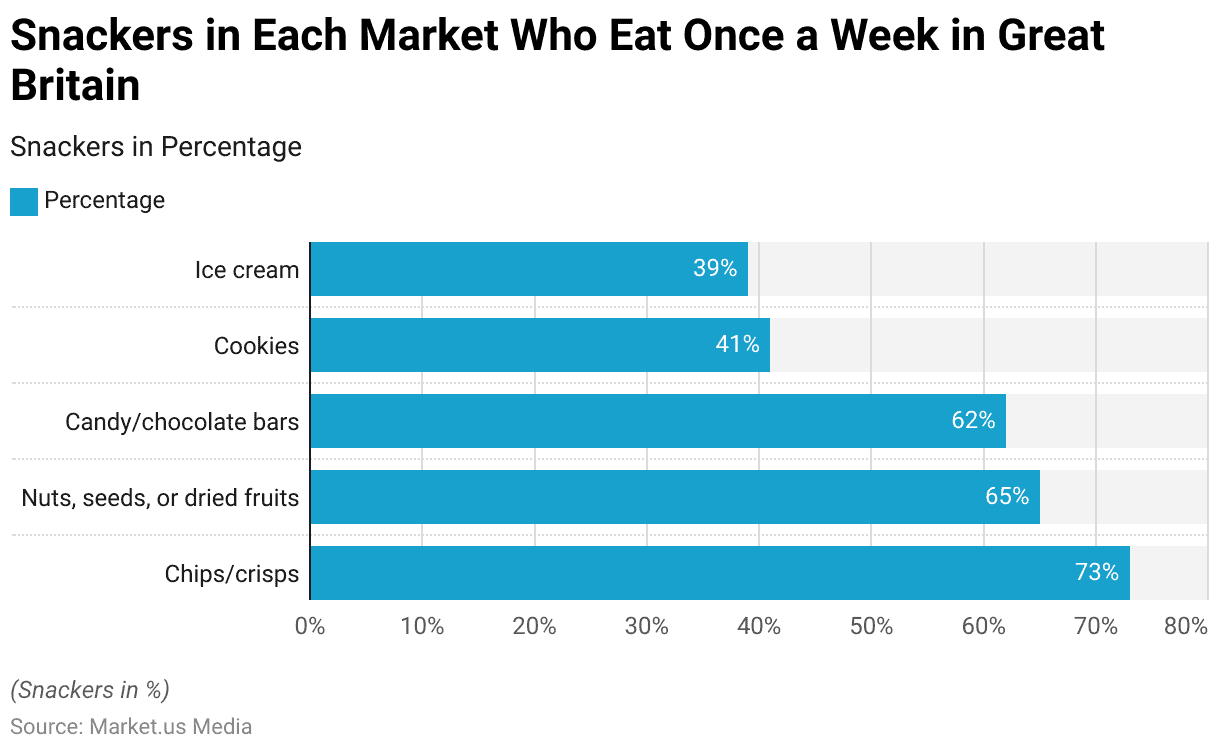
Germany
- In Germany, the weekly snacking habits of consumers reflect a diverse range of preferences across different snack categories.
- Notably, chips or crisps hold a prominent place in the snacking landscape, with a substantial 72% of snackers enjoying them at least once a week.
- Nuts, seeds, or dried fruits, while popular, exhibit a slightly lower frequency, with 44% of individuals opting for these nutritious choices regularly.
- Candy and chocolate bars also maintain a significant following, with 43% of consumers indulging in these sweet treats weekly.
- Meanwhile, cookies, though slightly less frequent, still find favor with 39% of snack enthusiasts. Additionally, ice cream, while less frequent in consumption, remains a favorite among 34% of the population.
- These statistics underscore the diverse array of snacking preferences in the German market, reflecting a blend of savory and sweet options that cater to varying tastes and snacking occasions.
(Source: YouGov)

Snacks Consumption According to Demographics
Snacks Statistics By Age
- In the United States, consumers are increasingly turning to snacks as meal replacements, and this trend varies across different age groups.
- Among individuals aged 18 to 24, a substantial 58% opt for snacks as meal replacements when at home, indicating a strong preference for this convenient and quick dining option.
- The trend continues among those aged 25 to 34, with 52% of this group choosing snacks as a meal replacement.
- Similarly, individuals in the 35-44 age bracket also exhibit a preference for snack-based meals, with 53% embracing this practice.
- However, as age increases, the inclination towards using snacks as meal replacements diminishes slightly, with 42% of those aged 45 to 54 opting for this approach.
- These statistics provide valuable insights into the shifting dietary habits among different age demographics in the United States, highlighting the growing popularity of snacks as a convenient meal replacement option, particularly among younger adults.
(Source: Statista)

Snacks Statistics By Gender
- On average, women tend to consume approximately 3.1 snack items daily, whereas men typically consume around 2.7.
- The primary driving factor for both genders when choosing snacks is taste. However, women are more inclined than men to select snacks based on specific expectations, such as seeking sweetness, crunchiness, or healthiness.
- In general, women appear to find a bit more satisfaction from indulging in sweets and snacks compared to men.
- When it comes to snack preferences in France, chocolate stands out as the snack that brings the most pleasure to people, regardless of their gender.
(Source: NPD Research, Statista)
Healthy Snacks Preferences Statistics
- In the realm of snacking, the concept of “natural” is closely associated with healthiness.
- Globally, consumers prioritize snacks that contain no additives or preservatives (40%), and lack artificial ingredients (34%). They feature natural ingredients with a clean label (33%) as their top choice for healthier snacks.
- In the United States, the consumption of protein-fortified snacks has risen across all age groups. With the most significant increase observed among individuals aged 32 to 45.
- When people reach for a snack, indulgence often plays a crucial role in their selection, even when health-conscious. This explains why dairy products like yogurt (69%), dairy milk (63%), and cheese (60%) are among the most popular snacks globally, offering both nutrition and indulgent taste and texture.
- While traditional indulgent snacks like biscuits, cookies, brownies (66%), chips (64%), and sweets and chocolate (60%) still have a strong presence. Consumers in Europe, Asia, and the US are cutting back on these less healthy options.
- In the US, for instance, protein bar users express interest in protein cookies (54%) and protein brownies (48%), demonstrating a growing demand for protein-enhanced snack alternatives.
- Protein chips (43%) and protein pretzels (42%) also receive favorable attention from current protein bar users.
(Source: Glanbia Nutritionals)
Latest Snacks Trends and Statistics
- According to the 2023 Snacking Survey conducted by Circana, nearly half of consumers. Which is 49 percent, report that they are now enjoying more than three snacks daily.
- This represents a notable increase of four percentage points in snack consumption within the past two years among households.
- These results highlight that consumers are increasingly turning to their favorite snacks as a cost-effective way to address their needs. Especially in challenging times, whether it’s for mental health or general well-being.
- A significant majority, which is 78% of consumers, express that they make an effort to enjoy indulgent snacks slowly. While 61% mention that they take the time to portion out their snacks before eating them.
- Snacking has become a routine for a considerable portion of the population, as 71% of consumers indulge in snacks at least twice daily.
- Interestingly, consumers are increasingly substituting traditional meals with snacks. With 55% indicating a higher inclination to have a snack during the usual breakfast, lunch, and dinner times.
- Environmental consciousness is on the rise, with 70% of consumers expressing a preference for snacks with minimal packaging, and 72% stating that they usually recycle snack packaging materials.
(Source: Circana Snacking Survey – 2023, Mondelēz International’s annual State of Snacking Report)
Recent Developments
Acquisitions and Mergers:
- In March 2022, Mondelez International Inc. expanded its portfolio by acquiring Chipta SA, a key player in the Central and Eastern European croissants and baked snack category.
- PepsiCo’s Acquisition of Bare Snacks: PepsiCo, a global leader in the food and beverage industry, completed the acquisition of Bare Snacks, a producer of baked fruit and vegetable snacks.
- The deal, valued at $200 million, strengthens PepsiCo’s portfolio of better-for-you snacks and aligns with its strategy to cater to the growing demand for healthier snacking options.
New Product Launches:
- Hostess Holdings introduced a new snack brand, Kazbars, in February 2023. Which is inspired by candy bars and marks a significant innovation within the snack cakes market.
- Nature Valley introduced its first savory snack option in May 2023, adding a new flavor dimension to its range of products.
- PepsiCo launched a premium range of potato chips under the Lays Gourmet brand in August 2022. Featuring high-quality ingredients and unique flavors like truffle parmesan and chili lime.
- Kellogg’s Launch of Rice Krispies Treats Snap Crackle Poppers:
- Kellogg’s, a leading cereal and snack manufacturer, introduced Rice Krispies Treats Snap Crackle Poppers, bite-sized snacks made with crispy rice cereal and marshmallows.
- The product launch aims to capitalize on the popularity of Rice Krispies Treats and offer consumers a convenient and indulgent snacking experience.
- Within the first month of its launch, sales of Snap Crackle Poppers surpassed 2 million units, demonstrating strong consumer demand for innovative snack formats.
Trends in Consumer Preferences:
- There is a notable shift towards healthier snacking options, with increasing consumer demand for snacks that offer functional benefits such as protein and fiber. This trend is complemented by innovations in the industry that cater to wellness-oriented consumers, looking for snacks that support digestive, immune, and overall health.
- Urbanization has also been identified as a significant driver for the snack industry. Urban consumers more likely to indulge in processed and convenient snack options.
Funding:
- SnackNation’s Series C Funding Round: SnackNation, is a snack delivery service focused on providing healthier snack options to workplaces and homes. Raised $50 million in its Series C funding round led by 3L Capital and backed by notable investors including Kraft Heinz and General Mills.
- The substantial investment will fuel SnackNation’s expansion efforts and support its mission to revolutionize snacking by making better-for-you options more accessible to consumers.
Conclusion
Snacks Statistics – In summary, the snacks industry is resilient and adaptable, driven by changing consumer preferences and lifestyles. It has a promising future with steady revenue growth. Consumers favor a variety of snacks, but health and sustainability are becoming more important.
Challenges include meeting regulations and addressing health concerns. Yet, competition fosters innovation, and data analytics plays a key role. Overall, the snacks industry’s ability to evolve and cater to consumer needs positions it for continued success in the global food market.
FAQs
The growth of the snacks industry is driven by changing consumer lifestyles. Increasing demand for convenient foods, and a wide variety of snack options.
Consumer preferences vary, but common snack types include chips, pretzels, popcorn, nuts, and cookies.
Snacks are distributed through various channels, including traditional retail stores, online platforms, convenience stores, and vending machines.
Yes, health-conscious consumers are increasingly looking for healthier snack options. Leading to the rise of snacks with cleaner ingredients and reduced additives.
Many companies in the snacks industry are working to reduce packaging waste and promote responsible sourcing of ingredients to align with sustainability goals.
Sources.

Trishita Deb
Trishita has more than 7 years of experience in market research and consulting industry. She has worked in various domains including healthcare, consumer goods, and materials. Her expertise lies majorly in healthcare and has worked on more than 400 healthcare reports throughout her career.
Latest from Author